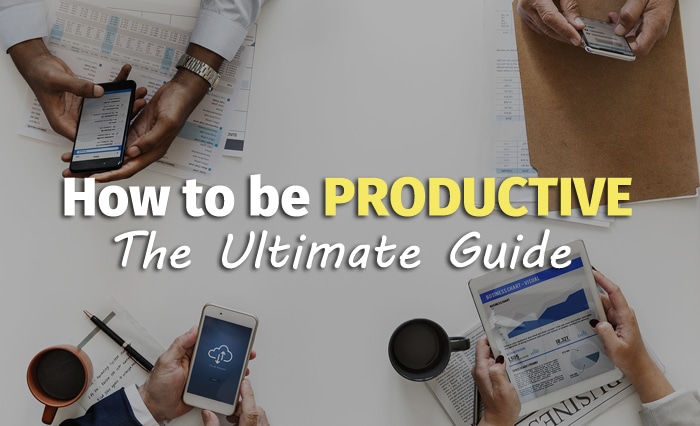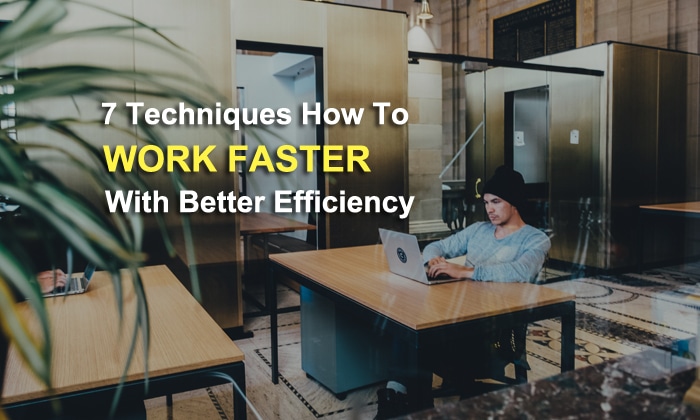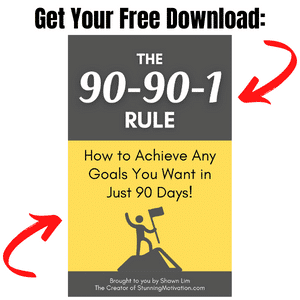Let’s talk about increasing productivity. We all want to have more time, to get more things done, and to beat our laziness so that we can be more productive to achieve all the goals that we set.
Unfortunately, there are just too many reasons why productivity can easily slip away from our hands.
For instance, the phone buzz, someone messages us on Whatsapp, we lack the motivation, too much distraction, feeling overwhelmed, etc, etc.
And if you are serious to increase your productivity regardless of whether it is at work or at home, continue to read on because you are about to discover some of the most powerful methods that you can easily implement into your life right now.
I have been reading a lot of books on productivity and doing a lot of research on the internet, and I discovered that if you want to be productive, there are a few areas you must learn to improve:
- Handling distractions,
- Managing his work,
- Build productive habits, and
- Using hacks to boost your productivity
If you know how to handle your distractions well but you have no idea how to build productive habits, there is no way you are able to get things done.
Conversely, if you know how to manage your work but you don’t know how to handle the distractions, there is no way you can focus too.
Therefore, increasing your productivity is all about taking care of all the related areas so that they will take your attention away.
So let us discuss how we can handle and manage each of these areas now. Let’s begin with the first factor that you must handle:
Handling Distractions

There’s a nemesis to productivity and his name is distractions.
The first thing you need to learn to be more productive is to learn how to protect your time from distractions.
There was a study covered by New York Times that said a typical office worker gets interrupted every 11 minutes, and it takes an average of 25 minutes to get back to the task.
Most of us try to focus on getting more things done. We often ask ourselves, what more can I do to be more productive?
However, sometimes it is not about what you should be doing, instead, it is about what you should stop doing, which is about getting rid of the archenemy of productivity – distractions.
Distractions are like the handbrake on your car. And the only way to go faster is to release the handbrake. If you choose to push the pedal faster and let the handbrake on, you will eventually suffer burnout.
The same goes when it comes to being productive. You must get rid of distractions in order to go faster.
Here are some great suggestions on how you can handle distractions at work.
1. Build your bunker
First, build a bunker. A bunker is a place where you shelter yourself from distractions. For instance, if you have an office room, lock yourself inside so that you can focus doing your work.
A bunker not only shelters yourself from distractions, but it can also work as a productive workspace where it puts you in the right perspective and boosts your motivation.
No matter if you work in the office or from your home, you must establish a place where you can work with 100% focus and without distractions. Here are some examples:
- Hanging a “Do Not Disturb” sign on your room door.
- Put up a headphone to eliminate outside noise or even interruption from your colleagues.
- Make use of blinds, curtains, and cubicle to block out distractions.
- Remote locations like a coffee house can also work as a great bunker.
2. Turn off the notifications
If you think that notifications are not all that distracting, think again.
How many times your phone buzzes and takes your attention away while you are working? How many times in day did you check your social media account because you receive a notification? What about instant messages like Whatsapp and Facebook message?
When you receive a message notification from Whatsapp, you are instantly distracted.
And for most people, they have been conditioned to check out the buzz instantly. And so they pick up their phone to check it out, only to discover that it is a forwarded message that is not important at all.
Do these distractions sound familiar?
There was a study conducted at the Florida State University and found that merely receiving a push notification is as distracting as responding to a text message or a phone call.
Here’s what one of the researchers said:
“Our results suggest that mobile phones can disrupt attention performance even if one does not interact with the device,” write the study’s authors. “As mobile phones become integrated into more and more tasks, it may become increasingly difficult for people to set their phones aside and concentrate fully on the task at hand, whatever it may be.”
So stop letting the notifications kill your productivity. Here’s what you can do:
- Turn your phone off, switch it to the “airplane” mode, or simply silent it when you are working.
- I keep my phone in the room when I’m writing articles, like now.
- Set a specific time to check your phone, such as once in the morning and once in the afternoon.
- Use distraction-free apps such as Freedom for Apple users and Forest for Android users.
- If all else fail, try to uninstall the unnecessary apps.
3. Organize your workplace
For the average people, they are going to spend a huge chunk of their time in the office than they do in their homes.
And this is why organizing your workplace is important because I’m sure that you don’t want to work in a messy workplace where you feel stress the moment you sit on the chair.
Many studies have discovered that a disorganized workspace can cause additional stress, lower your productivity, and also increase the risk of illness.
Not just that, the more clutter your workplace, the higher the chances that you will be distracted and lose your focus. Here are some tips to help you organize your workplace:
- Use a couple of minutes to organize your workplace at the end of each workday.
- Declutter and get rid of unwanted items on your desk that can distract you.
- Create a proper filing system to organize your papers and documents.
- Segment your work zones according to the nature of your work.
- Clean up and organize your laptop or desktop.
- Make the things that you need to use regularly within your reach.
If you want to learn more about organizing your workplace, I suggest you read this article from Huffington Post and this article from LifeHack.
4. Make use of white noise
Noise can be one of the biggest distractions of all. If you are working in a noisy environment, it is extremely difficult to focus.
Imagine you are trying to read a book in the market, do you think the noise will distract you?
Now, loud noise can distract you, but studies have shown that white noise or soft background noise can actually help people to focus better.
The Journal of Consumer Research stated that moderate level of white noise improves your imagination while a higher level of noise prevents information processing in your head.
When using correctly, white noise can work on a similar paradigm just like the Mozart effect, where certain classical music can spur your ability to solve problems and increase your creativity.
This is why I love to write articles and play some music at the same time. I find it especially helpful in the afternoon when I have used up most of my willpower to focus.
In the morning, my willpower is the strongest and I’m able to write continuously for a few hours. Whereas in the afternoon, I find it difficult to do so, and this is when playing my favorite music as the white background noise comes to help.
So the next time you have to work in a noisy environment, just plug in your headphone and listen to music.
Read: 5 Wonderful Background Noise Resources That Will Boost Your Productivity
5. Fuel your stomach
Another common distraction that never comes into most people’s attention is hunger. Hunger can be a big distraction and prevent you from performing at your best.
Just imagine going through your day without taking breakfast. You’re feeling hungry, but you can’t do anything and you have to work. Do you think you can focus and perform at your peak state?
No, not at all. Being productive is all about performing at your peak state so that you are able to get the most out of every hour.
There is no point to work longer hours if you can’t do your best and only deliver crappy work.
A nutritious diet not only feeds your body, it also feeds your mind. And research has discovered that keeping a steady glucose level throughout the day allows you to focus better and be more attentive.
Every morning, make sure you take nutritious breakfast. As the word suggests, “break-fast”. It is to break the fasting that you have gone through during your long-hour sleep. So never skip your breakfast.
Even if you are in a rush, take in some power bars or eat something quick that can fill your stomach.
And throughout the day, take small breaks from time to time and get some healthy snacks. Stock some snacks in your bunker, so that whenever you want to, you can reach them easily.
As for your lunch, try not to eat too full because if you overeat, your stomach has to work harder to digest the food. This is why normally when you eat too full for lunch, it can make you feel sleepy.
One more thing, drink more water and keep your body hydrated. The average person needs to drink about 2L or 8 glasses of 8-ounce water.
Manage Your Work

Getting rid of distractions is just the first step in building up your productivity. What you need to do next is to learn how to manage your work.
For most people, when it comes to being more productive, the first thought that comes to their minds is to work more or longer hours.
Spending more time on getting things done may not be a wise way to improve your productivity. You should spend your time on doing the most important work that will give you the most result rather than spending more time doing whatever that comes to you.
And this is why learning to manage your work is crucial. Here are some tips to help you in this.
1. Stop multitasking
When it comes to managing your work, try not to multitask, especially for works that require your attention or creativity.
For instance, while I’m writing articles, I can’t listen to audio programs or talk to someone. My brain simply cannot handle doing these tasks simultaneously.
The reason is that our brains can only focus on doing just one thing at a time. When I’m writing an article and someone talks to me, I need to stop, think about what he is telling me, process the information, and then reply him.
There is no way the two tasks can go hand-in-hand at the same time. This is why accidents can happen when people try to drive and talk on the phone at the same time. They split their attention and unable to focus 100% on either one of the tasks.
“We are wired to be mono-taskers. One study found that just 2.5% of people are able to multitask effectively. And when the rest of us attempt to do two complex activities simultaneously, it is simply an illusion.”
– Time.com
Read: 12 Surprising Reasons Multitasking Doesn’t Work
This is not to say that you cannot multitask. In fact, you can, but with tasks that require less of your creativity and attention.
For example, you are able to listen and sing your favorite song while mopping the floor. These tasks require no creativity and you don’t need that much brain power to mop the floor. Hence, multitasking will be alright in this case.
When it comes to writing article, I don’t listen to songs (with lyric), I choose to listen to music instead. I just can’t focus and will want to sing along if I’m listening to songs, and this makes me fail to focus on writing my article.
2. Chunk your work
Another great way to manage your work is to chunk your work into smaller pieces. Never underestimate the power of breaking down your work into smaller pieces because it helps you see clearly what needs to get done, plus, it helps lower your resistance to doing the work.
I suggest you read The One-Minute Rule that I have published earlier.
Basically, when you chunk down your work into smaller actionable tasks, you give yourself clarity on what to do and greatly increase your initiative.
A lot of people fail to act on their goals because the goals that they set are way bigger than their current ability to achieve, and more importantly, they don’t chunk down their goals into bite-size tasks that they can act on.
How do you eat an elephant? One bite at a time.
Imagine you just get back from work and you’re tired. But you have planned to exercise in the gym. It is raining out there and it takes 30 minutes to drive to the gym.
And if you think about this: getting change, driving 30 minutes to the gym in the rain, exercise for an hour, take a shower, drive back home, and then take your healthy dinner, these thoughts can turn you off.
You feel overwhelmed because there are too many things to do and the process is too complicated.
This is why you need to break down your goals into smaller chunks of tasks.
Now, imagine all you need to do is to change to your sports attire. And that is all. It sounds more simple and easy to do, right?
Once you get changed, you put yourself into action and the momentum will come. You will propel to take the following step, which is to get in your car and drive to the gym.
Hence, chunk down your work and use The One-Minute Rule.
3. Focus on doing the high-impact work
I believe that you have heard about the Pareto’s Principle or the 80/20 Rule. This is a famous ideology when it comes to productivity, for one reason, because it works.
The rule simply states that you should focus and put your time into doing the 20% work that gets you 80% of the results.
The problem with the majority is that they understand this principle, but only a few choose to apply it.
Think about all the tasks that you have done today or yesterday, are you focusing on doing the high-impact work, or do you do whatever that you think you should do?
Applying the Pareto’s Rule is not something difficult, but it does require your attention and awareness.
If you want to build a successful blog, you can:
- Build a fantastic logo
- Write and publish quality content
- Read books on how to do it
- Get a designer to build the best looking theme
- Create a Facebook page and announce your blog to the world
- Submit good content to other people’s blogs, known as guest blogging
- Keep yourself updated with the latest news in your niche
Of all the 7 action items above, what will you choose to do? If you apply the Pareto’s Rule, the high-impact tasks are none other than writing and publish quality content and guest blogging.
Other tasks such as creating an awesome logo, reading books on how to build a good blog, and design a great looking theme are considered low-impact tasks that you should do them last.
Can you see how this 80/20 Rule can help you in becoming more productive by getting the most relevant and result-yielding work done?
Scott Young has an article on his blog about how you can apply the Pareto’s Rule into each area of your life today. You can read it below.
Read: Twenty Unique Ways to Use the 80/20 Rule Today
4. Set deadlines or timeframes
You must create self-imposed deadlines for your tasks. Just like goal setting, without a deadline, it is not a goal, it is a wish.
Setting deadlines work because it gives you the sense of urgency.
Will you consider packing your luggage if your vacation trip is only happening in another 6 months time? No, you won’t bother to pack your luggage, why? Well, it is not urgent.
The same can be said for all your tasks and goals. If your goals don’t give you the sense of urgency, there is no point you will want to bother acting on them, right?
Here’s a great article you should read:
Achieve Far More by Working and Living with a Sense of Urgency
Developing urgency using deadlines is a double-edged sword. It can drive you to work faster and accomplish more, but at the same time, it can create stress and pressure that also kill your creativity.
So use this technique wisely.
A powerful tip that you can boost your productivity is by scheduling your deadlines as near to the present as possible.
For example, instead of giving yourself a full month to achieve your goal, schedule your task and give yourself a shorter deadline, say within a week.
Doing so will increase the urgency of achieving the goal and motivate you to act on it immediately.
This explains why short-term goals are extremely important. Rather than setting a goal to earn $100,000 within a year, set a shorter goal to earn $3,000 within a week.
Use the shorter time frame to motivate you into action. Plus, you will see the result faster and it kick-starts your momentum earlier too.
5. Customize your Pomodoro method
The Pomodoro technique is a great way to maintain your productivity throughout the day.
It is simple and easy to implement. The basic idea is that you need to schedule short regular breaks throughout your workday.
The Pomodoro technique suggests we work for 25 minutes and take a 5 minutes break. And then we continue the cycle for a couple of times before we take a longer 30 minutes break.
Of course, you don’t have to follow exactly. You can customize according to your own time frame.
For me, when writing articles for this blog, I will write for a longer duration when I’m “in the flow”, where the ideas run freely and I’m able to write continuously. And when I’m not in the flow, I will stop regularly, walk around, get to the balcony and take a short break.
It all depends on your tasks and your willpower to focus. I’m able to focus better in the morning. And in the afternoon, my work duration will be shorter.
You can try out this technique using App for your phone or the web version.
Marinara Timer (web version)
Pomodoro App (Android)
Focus Time (iOS)
Lifehacker has published a complete guide on how you can apply the Pomodoro technique in life and at work. You can read it here.
6. Start with the easy tasks
One of the main reasons people are not following their plan or taking action on their goals is because they lack the motivation.
It is true that we cannot solely depend on motivation to execute our work, but it is important to understand how we can leverage our motivation to get things done and become more productive.
The key here is to do the easy thing first, especially during the times when you don’t have high motivation.
Some gurus will suggest you do the difficult tasks first, just like what Brian Tracy suggested in his book, Eat That Frog.
However, there are both pros and cons for doing the difficult tasks first, and the same goes if you choose to handle the easy tasks first.
In my opinion, you should choose to work on the task base on your level of motivation and willpower. It is quite personal because everyone’s ability is different.
The conclusion is that you should choose to work on easy tasks first when you lack the motivation. The resistance and the willpower required to execute the easy tasks are low, plus, once you get yourself moving, you will build up the momentum.
If you choose to work on the difficult tasks first, the resistance is high and you may need a lot of willpower to execute the task. Hence, there is a higher chance that you’re going to procrastinate.
You have to decide for yourself. If you want to know the pros and the cons, read this article.
Remember, whether you choose to work on the difficult tasks first or the easy ones first are totally up to you. You just need to work on the one that works for you.
7. Time-Block
When it comes to managing your work for higher productivity, I found that the time-blocking technique to be ultra-effective.
The idea of time-blocking is simple and straight to the point, but it is extremely effective in helping you to stay focus on your tasks and get things done.
The time-blocking technique is a way where you organize your day in a series of time slots. And each of these blocks of time is dedicated to a task or tasks.
I first came across this idea from the bestselling book, The One Thing, written by Gary Keller and Jay Papasan. It is still one of the best productivity books ever written. I suggest you read it.
In my case, I time-blocked my morning time, from 9am to 11am, solely for writing content. I will not do any other things except chunking out content.
Time-blocking allows you to keep 100% focus on the tasks that you have scheduled. Rather than spending as much time on a certain task, time-blocking gives you a high level of clarity of what to do, when you should do it, and for how long.
Time-block your most important and high-impact tasks first.
If you are in sales, your most important and high-impact task is prospecting. So don’t spend your most important hours learning about your products or doing the document, do the most important work, which is to prospecting, to generate leads for sales.
And the most important of all, commit 100% to the tasks that you have time-blocked. This is vital because time-blocking is based on this principle. If you choose to do other things or allow other tasks to take away your attention during your time-block periods, what’s the point of time-blocking?
Therefore, if you have time-blocked say, 9am to 11am to call 50 prospects, make sure you do it. Never let any other task or anyone to disturb you. Lock yourself in your room and make the calls.
If you time-blocked your high-impact work and follow through, your productivity will soar because you are getting things done. Not just anything, but you get high-impact work done.
Building Productive Habits

Up to this point you have learned how to handle distractions and how to manage your time, now comes the most exciting part, which is to build productive habits.
You see, we all can be driven and motivated from time to time, but in order to keep our productivity high every single day, we cannot solely depend on our motivation and willpower.
There will be a time when you feel no energy and no motivation, where you don’t feel like you want to do anything at all. You just want to sleep or lie on the couch and do nothing.
Motivation is an emotion. And emotion comes and goes. Thus, we cannot depend on our motivation to get things done.
What we need then, is to develop good productive habits. Use our motivation to build the habits. And once the habits have formed, we need less energy to execute the task.
“We are what we repeatedly do. Excellence, then, is not an act, but a habit.”
– Aristotle
I love the quote above because it reminds me that success is about building great habits. It is not something that we do once in a while that determines our success, it is what we do consistently, each day, that will determine our success.
So here are some of the things you can do to build productive habits or should consider making them your habits.
1. Build your morning ritual
Learn to build habits, especially your morning habits. Some people call this a morning ritual. It is a set of routines that you carry out each day.
Morning rituals are important because morning is when you begin your day. And how you start your day says a lot about how your entire day will become.
If you start your morning strong and great, usually, the entire day will be great. On the other hand, if you start your morning lousy, feeling sad, depress, etc, your mood will affect the rest of your day and you may end up having a bad day. Common sense, right?
Creating your own morning ritual is not as difficult as you think. Read this article to learn how you can do it.
And if you want to know what are the great morning habits you can adopt, read my previous article:
7 Best Morning Routine to Kick-Start A Great Day
You just have to understand one thing, the beginning is the most difficult. For example, if one of your morning rituals is to wake up at 5am, the first few weeks is like going through hell.
You may feel sleepy and tired and totally uncomfortable, but once it has become your habit, things will become smooth.
Your body and your mind need time to make the adjustment to fit in the situation.
Hence, give yourself some time to get used to it. This is the sacrifice you need to make in order to build up good habits. Just like what Jack Ma says:
“Today is difficult, tomorrow is more difficult, but the day after tomorrow is beautiful.”
So endure until you become the person worthy of achieving the extraordinary results you desire. It is who you become that matters.
2. Schedule and plan your day
What is the point of setting your goals if you don’t want to plan for the actions and schedule the necessary steps to get there?
The same can be said about being productive. If you want to be productive, you must plan and schedule.
I know that some of you may think that your day may not goes according to your plan, but having a plan is much better than having no plan at all.
First, having a plan and knowing what to do give you a lot of clarity. Second, when you know what to do, you become proactive and you can start working on the right stuff.
Comparing to if you have no plan at all, you are in reactive mode. You respond to whatever that comes to your mind.
I like the metaphor that Tony Robbins used in his book, Awaken The Giant Within. Tony described that going through life without planning and without a clear destination is like the “Niagara Syndrome”…
I believe that life is like a river, and that most people jump on the river of life without ever really deciding where they want to end up. So, in a short period of time, they get caught up in the current: current events, current fears, current challenges.
When they come to forks in the river, they don’t consciously decide where they want to go, or which is the right direction for them. They merely ‘go with the flow’. They become a part of the mass of people who are directed by the environment instead of by their own values. As a result, they feel out of control.
They remain in this unconscious state until one day the sound of the raging water awakens them, and they discover that they’re five feet from Niagara Falls in a boat with no oars. At this point, they say, ‘Oh shoot!’. But by then it’s too late. They’re going to take a fall.
Sometimes it’s an emotional fall.
Sometimes it’s a physical fall.
Sometimes it’s a financial fall.It’s likely that whatever challenges you have in your life currently could have been avoided by making some better decisions upstream.
It is clear, isn’t it? That you need planning and scheduling to get to where you want. So stop the Niagara Syndrome and start taking control of your life, by making conscious decisions and planning for the results you want.
Make this your habit. Make planning and scheduling your habit.
You can do it daily, or you can do it weekly. For myself, I write down everything that I want to do each week, and then on the daily basis, I will go through my list, make amendments if need to, and more importantly, I take action according to my plan.
This is how people are able to achieve amazing success in life.
First, they start with a bold vision and an exciting dream. And then they turn their dreams and vision into goals with a deadline and specificity. Then, they figure out what they need to do to get there, they create plans and they schedule their lives around their goals.
And finally, each day, they commit themselves to taking action and execute the actions according to their plan.
My friend, this is how success is made. And do you know why planning is an important part of becoming productive now?
3. Make the task exciting and challenging
Have you ever heard about the Goldilocks’ Rule? I first learned about it from James Clear, where he wrote in his blog:
Scientists have been studying motivation for decades. While there is still much to learn, one of the most consistent findings is that perhaps the best way to stay motivated is to work on tasks of “just manageable difficulty.”
James used the example of playing tennis. When you play a serious match with a 6-year-old kid, there will be no match at all because it will be an easy win for you. Your motivation will be low because the match is way too easy.
On the contrary, if you play a serious match with international players such as Federer or Serena Williams, the match will be too difficult and you can’t even return their serves. It makes the match overly difficult. Your motivation will be low too in this case because the match is way out of your league.
This is what the Goldilocks’ Rule is all about, finding the “sweet spot” and making the task not too easy and not overly difficult.
You have to make the task or the challenge “just manageable”. When you work on something that is not guaranteed, but it is possible to achieve, your motivation will be highest.
For me, I find it the best to write and publish 2 articles per week on this blog. I try to go beyond and publish 3 articles, but it takes up too much of my time and eats up much of my energy, and the chance that I fail at it is high.
At the end of the day, I discovered that writing and publishing 2 articles per week for this blog will be the best choice. It gives me a sense of accomplishment that I achieved my target, and also the most satisfaction.
This is how I maintain my productivity in managing this blog. What about you?
Regardless of what industry you are in, apply the Goldilocks’ Rule into your work, and find the sweet spot that drives you the most.
When something challenges you and makes you excited and you can’t wait to do it, perhaps, it is a sign that you have found the sweet spot.
If you find your target overwhelming or too easy to achieve, maybe you should make some adjustments to it.
Productivity Hacks

Now comes the most exciting part of this ultimate guide, the productivity hacks.
I believe that at this point, you have learned quite a lot about how to become productive and how you can make the most of your time.
Some of the hacks you are going to learn below are common, while some will be more interesting. What is important is that you implement these hacks into your daily life.
If you are not doing anything about them and all you do is just read but no action, guess what, nothing will ever happen.
Yes, you will learn and gain new knowledge by reading, but the truth is that learning is just potential power. The real power comes when you implement what you have learned.
So let’s talk about the productivity hacks and how you can use these techniques to boost your productivity.
1. Give yourself a reward
This may sound common, but when implementing correctly, it can boost not just your productivity, but also your motivation to take action.
Have you ever felt so driven that you are willing to do something and go the extra mile?
Besides reading, I love to play badminton and games. I used to drive an hour in peak traffic hours just to play badminton with my friends. When I think about it, the only factor that motivates me to drive an hour during traffic congestion and to get to the court 20km away from my place is none other than the great reward.
I get to enjoy the game that I love. I enjoy being with my friends and playing badminton together. And this is what a reward system can do for you too.
If you’re a gamer, you’ll have heard about a famous game called Final Fantasy 7. It was the first game that I’m so addicted and recently, I searched all over the web just to download the game and play it again on my laptop.
I’m not sure about you, but I do believe that there are rewards that you craved for, that you are willing to do whatever it takes to get it.
And you can use this reward system to increase your productivity. Give yourself a reward that you craved for when you complete your task.
For example, you can reward yourself with 30 minutes of game time when you follow your plan and go jogging for an hour.
There are many ways how you can use the power of reward to improve your productivity. You just need to be creative and brainstorm the way.
In sales, companies are rewarding their salespeople with cars, luxury travel, iPads, iPhones, and more to increase the sales.
So give yourself a reward that you love and are looking forward to.
2. Make up the commitment
“When there is a will, there is a way.”
The quote above perfectly describes this productivity hack. When you are committed, you are willing to do whatever it takes to achieve it. But when you’re interested, you will do what is convenient.
Hence, make it a commitment to accomplish your task. So how are you going to do that? Well, the answer can be pretty simple, you make up the commitment.
For instance, you can announce it to the world and share it with others of what you are going to do.
I can tell you right now that I’m publishing 2 articles on Stunning Motivation a week, every Tuesday and Thursday. After I have made this announcement, I feel the pressure to keep my words.
The key is to put yourself on the line so that you will be committed to taking action.
Hitting the gym alone can be boring and it is one of the most common reasons people procrastinate going to the gym despite having paid hundreds for the membership.
What you can do to build up the commitment is by taking in a partner, or engages a trainer to guide you through the workout process. When someone is waiting for you in the gym to workout together, your chances of procrastination will be much lower.
Thus, create the commitment. Build up some pressure so that you feel obligated to take action.
3. Utilizing your most productive hours
Another thing you can do to make the most out of your day is to utilize your most productive hours.
For me, my most productive hours are in the morning. Usually, I feel more difficult to focus and it can be a little more challenging to work on my creative tasks in the afternoon.
So my most productive hours are in the morning. Therefore, I schedule my morning for my most important work, which is content creation. And in the afternoon, I usually spend time on other tasks such as creating Facebook posts, reading and leaving comments on other’s blogs, creating infographics, etc.
In the morning, I’m able to write a lot of content and the ideas will just flow as I’m writing. While in the afternoon, I find it more difficult to come up with ideas to write and I will be easily distracted and wanted to walk around after a couple of minutes of writing.
Everyone’s productive hours are different. Some people are most productive in the morning, like me, while some are most productive in the afternoon.
What you need to do is to find out the time when your motivation, willpower, and productivity are at their peak, and then schedule high-impact and important work during those hours.
4. Create more visual triggers
Studies have discovered that visual triggers such as motivational posters actually increase employee’s performance by as much as 33%.
It is time to decorate your workstation. Visual triggers like motivational posters, inspirational quotes, and vision boards are great for boosting your productivity and motivation.
According to BOSTI Associates, a workplace planning and consultancy firm in New York said:
“There is a clear correlation between how people experience the offices they work in and their productivity levels on the job, including job performance, satisfaction and their ability to communicate with each other.”
There was also a survey done by Business Committee for the Arts, which stated that:
“82% of employees said art was important in the work environment, and 73% percent said their view of the company would change if the art were removed.”
Can you see how impactful visual triggers can influence your productivity right now?
So take some time to decorate your workplace. Whether you work in the office or from home, you need a proper workstation in order to perform at your best.
Read: 15 Office Design Tricks That Will Increase Your Productivity at Work
And read: 7 Tried-and-True Secrets for a Productive Home Office
5. Use the “Calendar Method”
Have you ever heard of the “Calendar Method” or the “Jerry Seinfeld Calendar Method”?
I have written an article about this method before and you can read it here.
Let me explain it quickly what this method is about. Basically, it is a great way to increase your productivity by measuring your progress.
All you need to do to use this method is a table calendar. For example, if your task is to write 1,000 words of content each day, every time after you have completed the task, put a big “X” on your calendar.
This marks that you have accomplished your task for today. And your mission is to keep the big “X” chain continue for as long as possible. Do not break the chain.
The reason this technique is powerful is that it is simple to use and whenever you put a big “X” on your calendar, it makes you feel great because you have just accomplished a big milestone of the day.
Besides that, whenever you look at the calendar, it reminds you of your task, plus, it also motivates you to take action not to break the chain.
Pretty simple and powerful, isn’t it?
You can schedule your most important work and use this calendar method to measure your progress.
As for me, every day once I completed my task of writing 1,500 words, I will put a big “X” on my calendar next to my laptop.
I can see the calendar clearly and it also serves as a great reminder for my target for the day.
Go ahead and get yourself a table calendar. Apply this method to your most important task and start crossing your calendar from now on.
6. Make your tasks “in the flow”
Another great hack to make yourself productive is to make your task within your flow of work.
You can either make an action in the flow or out of the flow. Allow me to explain.
If you want to get rid of the bad habit of watching TV, what you can do is to unplug your TV or simply turn the TV around.
What you’re trying to do here is to make it difficult to watch TV. You make the process “out of the flow” by making it difficult to act.
If you want to get rid of the habit of smoking, make smoking difficult. Keep the cigarette somewhere hard to reach. This will greatly lower your drive to smoke because you make it difficult to do it.
At the same time, you can do the opposite and make things “in the flow” too.
If you want to go exercise later today, make it easier to do so by taking out your clothes and put them somewhere visible. You can also get everything ready by keeping them in your car.
If you want to be a successful blogger and write content regularly, make your blog the homepage on your browser.
Make things easy or in the flow so that the resistance to doing it is lower.
So identify the actions you can take make your tasks either “in your flow” or disturb the progress by making the task “out of your flow”.
Feeling Overwhelmed?
So what should you do right now? If you have read until this point, there are so many things you can do right now. So where should you start?
Start with CLARITY.
In my opinion, being productive is about having absolute clarity of what you want to accomplish. Without knowing your destination, there is no way you can come up with a plan to get there.
What you can do right now is to find out the clarity in what you do.
Discover what it is that you want out of your life. And then find out the actions that you need to take to get there. Organize your life around the actions. Follow the Pareto’s Principle and choose to do the more important work that gives you the most result.
If you’re feeling lost right now, don’t worry, start with clarity, and then look at the 4 areas of productivity again:
- First, you get rid of the distractions.
- Second, you learn to manage your work.
- Third, you turn your daily important work into habits.
- Fourth, you implement some of the productivity hacks to help you in the progress.
Conclusion
You have come a long way in this article. I hope you enjoy reading this article as well as learning something valuable here.
If you like what you read, remember to share it with your fellow friends. Let them become productive too.
And finally, let me know what you think about this article by leaving your comments below. Share with me your thoughts and ideas how you increase and maintain your productivity throughout the day.













Comments 1